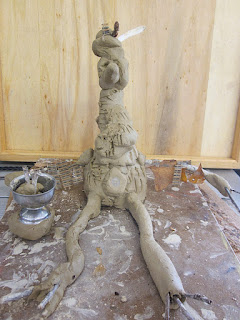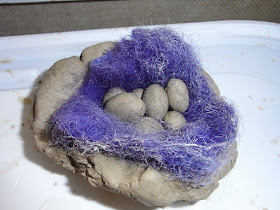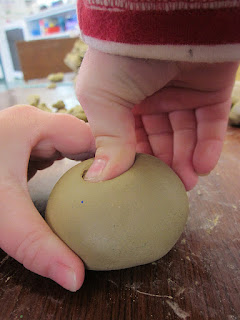One of the key elements of visual art is form, or shape in three dimensions. Clay is a particularly useful resource for children to explore form, because as they manipulate it, squeeze it and pile it up it produces immediate and very satisfying results. After making pinch-pots with the children last week, the children’s clay work had really taken off, and some superb creative and imaginative sculptures have been created.
The following photographs document the processes involved in making Kura Ngaituku (the Birdwoman), and all stemmed from reading 'Hatupatu and the Birdwoman', a story from the book by Gavin Bishop called 'Riding the waves. Four Maori myths'.
Here is a little extract, as you can see the writing is wonderfully descriptive, you really get a sense of what Kura Ngaituku looks like – a little frightening I think – perhaps this is why the children love this story so much (in the book however you never see a full image of her, other than of her very long nails and a glance of her face).
"Kura Ngaituku was a birdwomen. She was as tall as a tree, and her fingernails were so long she used them as spears. On her arms she had great feathery wings. And her stretchy legs allowed her to travel great distances with just one stride" (p40).

The children demonstrated great initiative in using props such as the ribbon and leaves to get the effect they wanted. Technical problem-solving is required for a complex piece like this, for instance in using sticks inside the clay to stop it collapsing.
“As young children's skill with clay develops … increasingly complex experiments with form take place that can result in the creation of sophisticated and accomplished clay pieces.” (Lisa Terreni, Ministry of Education)
As the children worked to design, build and solve their problems with the clay they often collaborated, sharing and communicating their skills and knowledge with each other. I really love the children's use of a button for a belly-button here.

More problem-solving; despite many attempts to get Kura Ngaituku’s feathery wings to stick (they kept falling off!), after some thinking, it was off to the hot glue gun table.
Here are some other great clay sculptures produced by the children this week.

More problem-solving; despite many attempts to get Kura Ngaituku’s feathery wings to stick (they kept falling off!), after some thinking, it was off to the hot glue gun table.
Making something solid, with a front, back, sides, inside, top and underneath is particularly motivating to many children.
Doesn't Kura Hatupatu look fantastic?
Christine










































